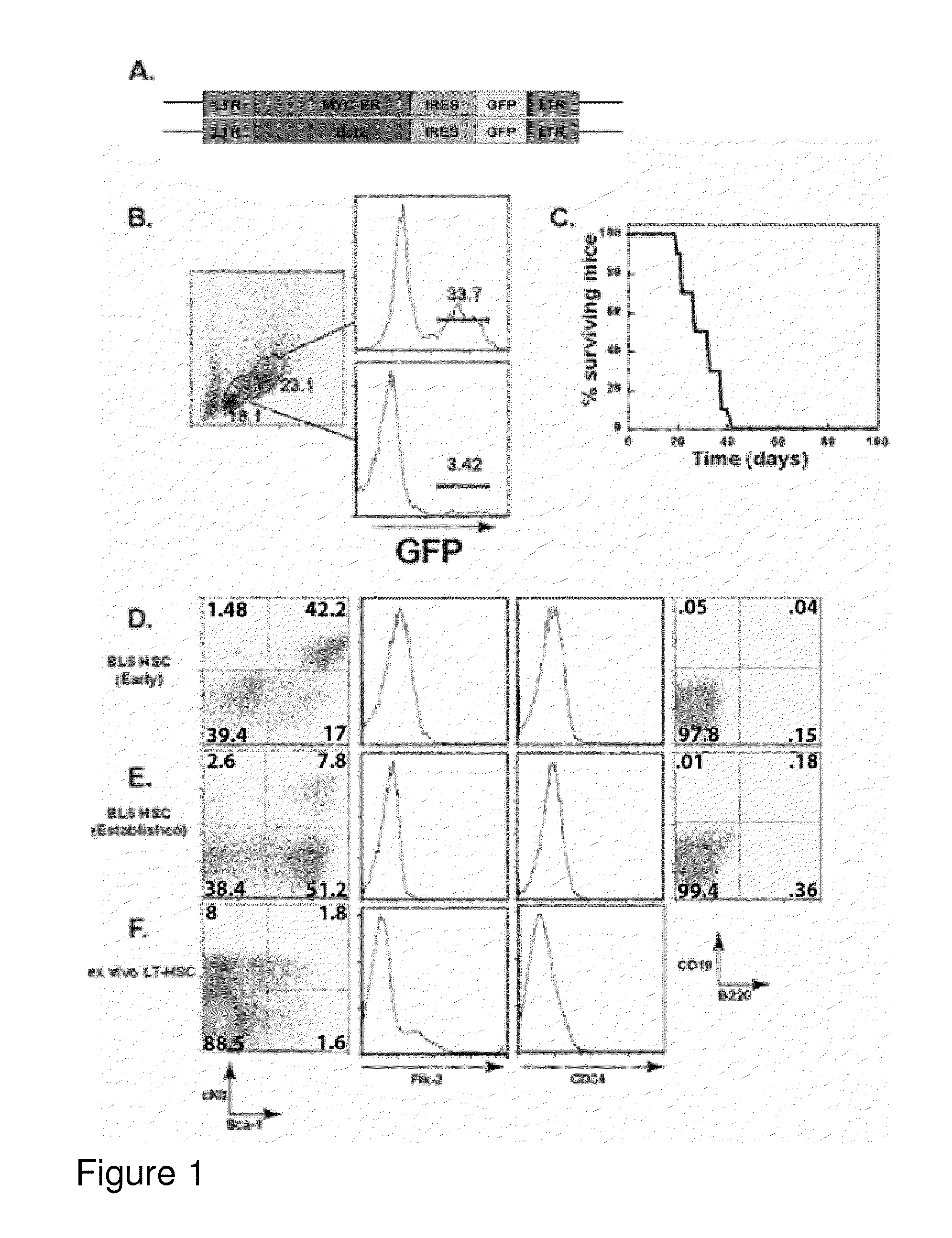Production and use of red blood cells
a technology of red blood cells and red blood cells, which is applied in the field of production and use of red blood cells, can solve the problems of ineligible rbc transfusion, short life span of rbcs, and tremendous challenges, and achieve the effects of reducing fetal hemoglobin, reducing cd71, and increasing adult hemoglobin
- Summary
- Abstract
- Description
- Claims
- Application Information
AI Technical Summary
Benefits of technology
Problems solved by technology
Method used
Image
Examples
example 1
Generation of Conditionally Transformed Long-Term Reconstituting Hematopoietic Stem Cell Lines
[0269]HSC-enriched bone marrow (BM) cells were prepared by treatment of mice with 5-fluorouracil (5FU) to ablate proliferating cells. Ex vivo BM cells from treated mice were further enriched for HSCs by culturing in medium containing IL-3, IL-6, and SCF, as previously described (Van Parijs et al., Immunity 11, 763-770, 1999). Cells were then subjected to three rounds of spin infection with pMIG-MYC-ER and pMIG-Bcl-2 viruses encoding oncoproteins as well as green fluorescent protein (FIG. 1A) (Refaeli et al., J. Exp. Med. 196, 999-1005, 2002). Variants of the pMSCV backbone were generated to encode the cDNAs for human MYC-ER or Bcl-2 as well as an IRES element and a reporter gene (EGFP). The resulting viruses generated bi-cistronic transcripts such that the level of reporter gene expression correlated with the level of expression of the first cDNA.
[0270]This treatment yielded a rate of retro...
example 2
Conditionally Transformed HSC Cell Lines Exhibiting a Lt-HSC Surface Phenotype
[0272]To assess the phenotype and homogeneity of the cell lines developed in Example 1, the cellular expression of a variety of surface markers was analyzed. Cells were stained with antibodies to c-kit, Sca-1, CD34, and Flk-2. Additionally, the cells were stained for specific lineages: CD19 and B220 for B-lineage cells, Thy1.2 for T-lineage cells, Mac-1 for myeloid cells, Gr-1 for neutrophils, and Ter-119 for red blood cell progenitors. As shown in FIGS. 1D-1F, the phenotype consistently observed was lineage negative (CD19−, B220−), but Sea-1+, c-kit+, CD34−, and Flk-2−. This pattern of marker expression is consistent with that previously reported for murine primary Lt-HSCs (Cheshier et al., Proc. Natl Acad. Sci. USA 96, 3120-3125, 1999). It was also noted that when ctlt-HSC cell lines were maintained in culture for extended periods of time, cellular c-kit expression decreased (FIG. 1E). This change is not...
example 3
Rescue of Mice from Lethal Irradiation by Transplantation of ctlt-HSCs
[0277]This example demonstrates that ability of ctlt-HSC cell lines to give rise to differentiated red blood cells (RBCs). This ability, as well as competence to maintain an active HSC compartment for extended periods of time, is critical to establish the identity of ctlt-HSC as Lt-HSC. The ability of the ctlt-HSC cell lines to reconstitute the hematopoietic compartment of lethal irradiated animals was examined in two ways. First, 103 ctlt-HSC cells along were transferred with 3×105 whole bone marrow cells from Rag-1− / − mice into lethally irradiated young C57 / BL6 mice. The addition of the “carrier” Rag-1− / − cells ensured that recipients could produce red blood cells during the period of time required for transferred HSCs to re-establish erythropoiesis. Supplementation with whole “carrier” bone marrow cells is generally used in conjunction with HSC reconstitution in order to allow transplant recipients to survive t...
PUM
 Login to View More
Login to View More Abstract
Description
Claims
Application Information
 Login to View More
Login to View More - R&D Engineer
- R&D Manager
- IP Professional
- Industry Leading Data Capabilities
- Powerful AI technology
- Patent DNA Extraction
Browse by: Latest US Patents, China's latest patents, Technical Efficacy Thesaurus, Application Domain, Technology Topic, Popular Technical Reports.
© 2024 PatSnap. All rights reserved.Legal|Privacy policy|Modern Slavery Act Transparency Statement|Sitemap|About US| Contact US: help@patsnap.com










